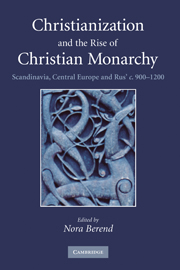
-
Select format
-
- Publisher:
- Cambridge University Press
- Publication date:
- June 2009
- November 2007
- ISBN:
- 9780511496400
- 9780521876162
- 9780521169301
- Dimensions:
- (228 x 152 mm)
- Weight & Pages:
- 0.84kg, 460 Pages
- Dimensions:
- (229 x 152 mm)
- Weight & Pages:
- 0.67kg, 460 Pages
You may already have access via personal or institutional login
Book description
This 2007 text is a comparative, analysis of one of the most fundamental stages in the formation of Europe. Leading scholars explore the role of the spread of Christianity and the formation of new principalities in the birth of Denmark, Norway, Sweden, Bohemia, Hungary, Poland and Rus' around the year 1000. Drawing on history, archaeology and art history, and emphasizing problems related to the sources and historiographical debates, they demonstrate the complex interdependence between the processes of religious and political change, covering conditions prior to the introduction of Christianity, the adoption of Christianity, and the development of the rulers' power. Regional patterns emerge, highlighting both the similarities in ruler-sponsored cases of Christianization, and differences in the consolidation of power and in institutions introduced by Christianity. The essays reveal how local societies adopted Christianity; medieval ideas of what constituted the dividing line between Christians and non-Christians; and the connections between Christianity and power.
Reviews
Review of the hardback:'This volume constitutes an invaluable resource for our understanding of a crucial period in the formation of Europe.'
Source: Journal of Ecclesiastical History
Contents
Metrics
Full text views
Full text views help Loading metrics...
Loading metrics...
* Views captured on Cambridge Core between #date#. This data will be updated every 24 hours.
Usage data cannot currently be displayed.
Accessibility standard: Unknown
Why this information is here
This section outlines the accessibility features of this content - including support for screen readers, full keyboard navigation and high-contrast display options. This may not be relevant for you.
Accessibility Information
Accessibility compliance for the PDF of this book is currently unknown and may be updated in the future.


